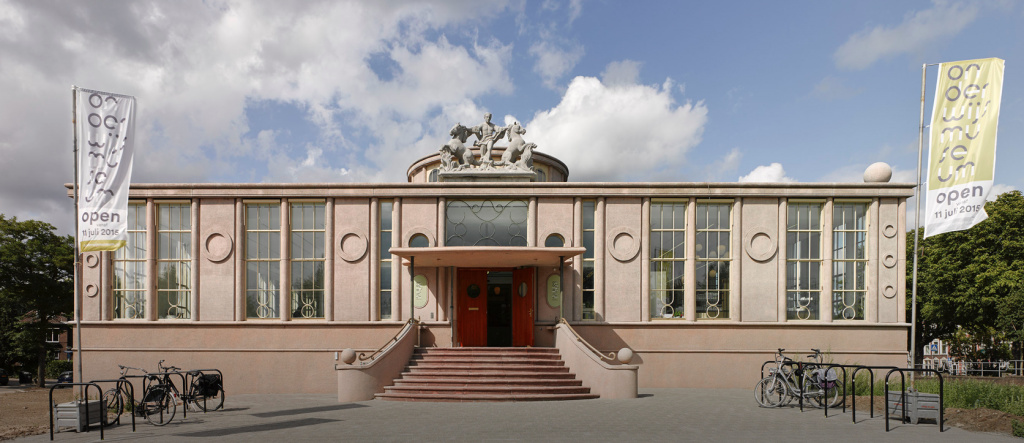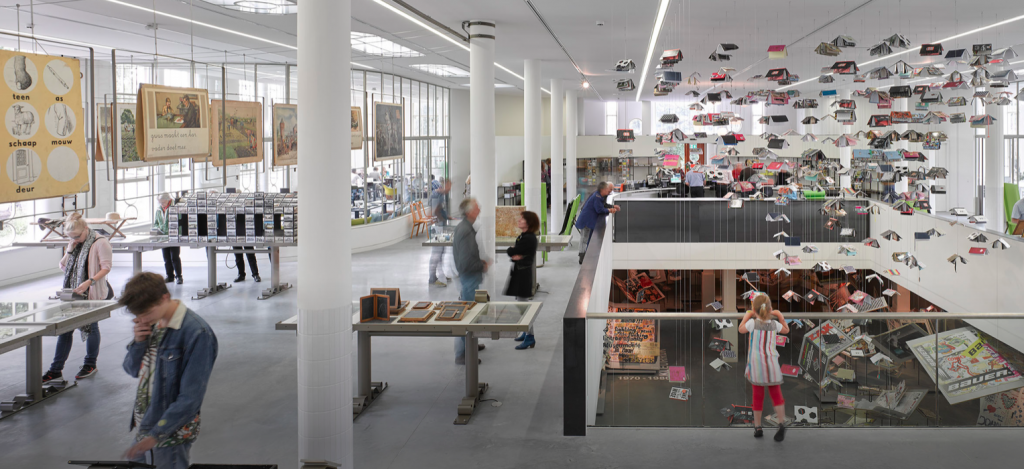Museummuis & Onderwijsmuseum

Aaaand… yet another new category for this blog, after my nickname which literally translates to “museum mouse” and incorporates my initials as well (I never understood why it is not “museummus” which would be “museum sparrow”, but anyway). For this first blog in the new category, I’ll write about some of my experiences with the Dutch museum of education, aka het “Nationaal Onderwijsmuseum”.

The National Museum of Education is located in Dordrecht, in the beautiful building called ‘De Holland’. This municipal monument was built in 1939 in Dordrecht to a design by the Dutch architect Sybold van Ravesteijn (1889-1983). From 2015, the renewed museum has opened its doors festively. The entire collection in care of the museum consist of over 350.000 objects that are in some way related to education; from textbooks, wall-charts, ink jars, atlases, photo’s and educational films to diaries and schoolbags. Besides the permanent collection – on display on the first floor – there is a continuously changing exhibition in the basement. In this blogpost, I’ll describe one of the three temporary expo’s that I have visited, about hypes and trends.
That time, I was together with a friend and we were lucky enough to be guided around by Channa Benders, an excellent museum educator, who showed us the most extraordinary, rare and most beautiful items of the museums grand collection. We were amazed by the classic 18th century ‘Hornbook’, recognised the nostalgic ‘Aap Noot Mies’ reading method, and admired the fine wall charts by Cornelis Jetses and the unique tellurium by Van Laun. Channa told us fascinating, sometimes personal, often funny and in a few cases emotional stories that shaped Dutch education throughout the past few centuries. And then it was time to go downstairs, to immerse ourselves in the hypes and trends.
This exhibition was a feast of nostalgia, especially for my friend and me. Thus, this exhibition about trends is also in line with a trend: playfulness. And the so-called “kidults” that marketers respond to with games for adults and references to toys from the 80s and 90s. Experts suggest a number of reasons for the popularity of that trend, that are all applicable to the Onderwijsmuseum in general en this exhibition in particular:
- It taps into a fun, stress-free era, escaping current problems and uncertainties.
- It draws on our collective memory of the past, connecting us through a sense of collaboration.
- It brings out our ‘inner child’, making us feel youthful and energised.
- It embraces creativity, humour and optimism.
- It is spontaneous and interactive, releasing us from ‘grown-up rules’ and structures.

Moreover, my friend and I jokingly called the basement “an Aspergirls’ Heaven”, for it featured so many of our autistic special interests. For the neurotypical readers of this blog: often, autistic persons have been observed to indulge passionately and intensively while doing specific activities. And these activities are usually referred to as ‘special interests.’ Researchers indicate that special interests revolve around the mechanical aspect of how things work as opposed to the psychological point. Just like hobbies for ordinary people, special interests are for autistic people. In the current dynamic society, there are a lot of hypes and trends that are associated with autistic people. These trends conflate with the special interests of autistic people and as such help and motivate the interest of autistic persons.
In this exhibition, we saw various toys and play items (such as virtual games) that are recommended for autistic persons. These toys often appeal to fantasy things and creative interests of the subject hence they prevent from destructive behavior by providing a distraction or a point of focus for their attention. Furbies and squishies are the most common toys which are recommended for autistic persons. Several parents have recorded that the Furby helped their children to speak, especially by increasing vocabulary and improving reference to self. Squishies, on the other hand, act to relieve stress and anxiety. Squishies also come in adorable shapes that appeal to fantasy objects such as unicorns hence they improve concentration.
Funnily enough, my friend and I watched the showcases full of Pokémons while we played on our phones, to incorporate an even later rage in the market: Pokémon GO (Mehta, 2016). This game is basically is an upgrade from the old Pokémon game that most millennials played in childhood. Whereas Pokémon GO is an augmented reality, the older version is all virtual. Favorite reviews and recommendations from parents with autistic children and psychologists indicate that the new game appeals to fantasy things such as monsters and motivates children and young adults with autism to leave the house or their comfortable spots and explore. Furthermore, the game allows the players to interact with everyone around them. Experts reveal that people with autism tend to take up collecting as a hobby hence Pokémon GO gives autistic persons the chance to do so.
But while playing games on our phones is normally an “autistic” trick to withdraw from the overwhelming world for a moment, it was not necessary at all in the Education Museum: there was a huge box with squishies in it to lie, feel, smell and relax. What did i say? Aspergirls’ Heaven! 😉 But seriously, how nice is it, that finally, I can enjoy things from my childhood in a safe environment? Moreover, some of my children’s art – that was always mocked by the teacher and the other children – was shared by the Onderwijsmuseum, which felt like a healing experience. (#1 #2 #3)
Next to their exhibitions, the National Museum of Education has a wonderful museum cafe (with divine cakes), is very active on social media and organizes a variety of projects, such as lectures and film screenings. My friend the youth psychologist & I went to a “dinner & movie”-evening at the museum. We had fabulous food and saw the impressive documentary film “Spiegeldromen” (Mirror Dreams), about the lives of teenagers in special needs education. It was both beautiful and confronting to hear this vulnerable group talk about their daily lives, their struggles, hopes and dreams. (Also, the metaphor of the crumpled paper came by again.) And together with yet another friend, I had coffee in the beautiful garden and participated in a drawing workshop.
The museum also contributes to the website www.historywallcharts.eu . This website shows wall-charts from various European countries, which were meant for history lessons. The wall-charts on display belong to the collections of Denmark’s Paedagogiske Bibliothek (National Library of Education, Denmark), of the Forschungsstelle: Schulwandbild (department of the University of Würzburg, Germany) and of the National Museum of Education in Dordrecht. Certainly worth a visit! My personal favourite is this one, with illustrations from the Sachsenspiegel. 🙂
To end this blogpost, I’d like to share two more YouTubes with you. Both are in Dutch (sorry). The first one is podcast made by my friend Rolf & me, about the stories behind the Onderwijsmuseum. In this podcast we explore the Onderwijsmuseum and interview its director Tijs van Ruiten. It became a conversation about the problems of medium-sized museums, on how big data from the museum card was used to make more efficient use of hospitality facilities and opening times, how old ladies (who like their pastries and drinks) are actually the ideal visitors and how the museum could survive with less subsidy while still remaining relevant. Finally, we talked about the special accommodation, designed in 1939 by “the most demolished architect in the Netherlands”.
The second one is a video-fragment from the reportage Peter & I made about a large annual Utrecht event called “De Nationale Onderwijstentoonstelling” aka “The National Education Exhibition”. In this filmclip, starting at 19:55, I interview two other experts from the Onderwijsmuseum, Marianne Pas en Janneke Pierhagen.
I hope that you have enjoyed this virtual museum visit with me. Have you even been to the Onderwijsmuseum or a similar museum? What is your favourite museum? And please let me know which museum you think that this Museummuis should visit – and blog about – next! 🙂

I enjoyed this virtual tour a lot. It’s been a while since the last one.